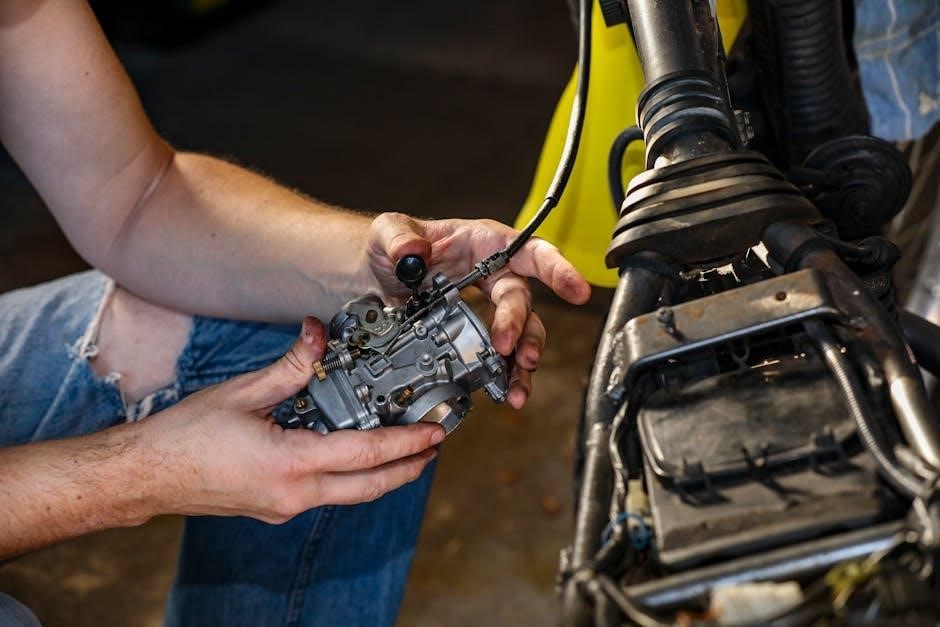The Zenith Carburetor Manual PDF provides comprehensive guidance for repair, maintenance, and troubleshooting of various Zenith carburetor models, ensuring optimal performance and longevity of your engine.
1.1 Overview of the Zenith Carburetor Series
The Zenith Carburetor Series includes various models like the 28, 228, 61, 62, 63, 263, 67, 68, 161, 267, and the 29-Series, each designed for specific engine applications. These carburetors are known for their downdraft and updraft designs, offering precise fuel-air metering and balanced performance. The 29-Series features a sealed and balanced design, ensuring optimal airflow for idling and fuel bowl ventilation. Zenith carburetors are engineered for reliability and efficiency, catering to both vintage and modern engines.
1.2 Importance of the Manual for Repair and Maintenance
The Zenith Carburetor Manual PDF is an essential resource for technicians and enthusiasts, offering detailed repair and maintenance guidance. It provides troubleshooting tips, step-by-step instructions, and exploded views to ensure proper disassembly and reassembly. The manual covers diagnosing common issues like flooding and rich/lean mixtures, as well as adjusting components such as the choke tube, main jet, and idling jet. Regular maintenance procedures, like cleaning and replacing worn parts, are also outlined to keep Zenith carburetors functioning optimally and ensuring engine performance.
History and Development of Zenith Carburetors
Zenith carburetors, established in the early 20th century, revolutionized fuel delivery systems with innovative designs, becoming a cornerstone in automotive and aviation industries.
2.1 Early Models and Their Significance
The Zenith carburetor’s early models, introduced in the early 20th century, laid the foundation for modern fuel delivery systems. Known for their simplicity and durability, these carburetors quickly gained popularity in the automotive industry. Their innovative designs, such as the updraft configuration, made them ideal for early engines. The success of these models established Zenith as a trusted name, paving the way for advancements in carburetor technology that would shape the industry for decades to come.
2.2 Evolution of Zenith Carburetors Over the Years
Zenith carburetors underwent significant advancements, adapting to engine demands and technological progress. Early models focused on simplicity, while later designs incorporated improved metering systems and vacuum-operated components; The introduction of emissions regulations led to more efficient and environmentally friendly designs. Continuous innovation ensured compatibility with modern engines, enhancing performance and fuel efficiency. This evolution reflects Zenith’s commitment to meeting industry needs while maintaining its reputation for reliability and precision.

Key Features of Zenith Carburetors
Zenith carburetors are renowned for their durability, fuel efficiency, and smooth operation, featuring precision-engineered components and advanced design for optimal engine performance and reliability.
3.1 Downdraft Design and Fuel-Air Metering
The Zenith carburetor features a downdraft design, which enhances airflow by drawing air downward through the carburetor, reducing turbulence and improving intake efficiency. This design allows for better fuel-air metering, ensuring a precise mixture for optimal combustion. The carburetor’s internal passages are carefully engineered to maintain consistent airflow velocity, while the vacuum-controlled jets deliver fuel accurately. This results in smooth throttle response, efficient fuel consumption, and reliable engine performance across various operating conditions.
3.2 Sealed and Balanced Design for Optimal Performance
The Zenith carburetor’s sealed and balanced design ensures precise airflow control and consistent fuel delivery. This design minimizes air leaks and turbulence, providing a stable fuel-air mixture across all engine speeds. The balancing feature ensures even airflow distribution, enhancing throttle response and reducing hesitation. This design also improves fuel efficiency and overall engine performance by maintaining optimal combustion conditions. Regular maintenance, as outlined in the manual, helps preserve this balance and ensures long-term reliability.

Zenith Carburetor Models Covered in the Manual
The Zenith Carburetor Manual PDF covers various models, including the 28, 228, 61, 62, 63, 267, and 29-series, providing detailed specifications, installation tips, and maintenance guides.
4.1 Zenith 28 and 228 Carburetor Specifications
The Zenith 28 and 228 carburetors are renowned for their durability and performance. These models feature a downdraft design with a venturi size optimized for specific engine applications. The manual provides detailed specifications, including fuel flow rates, throttle responses, and air-fuel mixture adjustments. Designed for reliability, these carburetors are often used in vintage and classic vehicles, with the 228 model offering slightly higher performance capabilities. The guide ensures users understand proper installation and tuning for optimal engine efficiency.
4.2 Zenith 61, 62, 63, 263, 67, 68, 161, and 267 Models
The Zenith 61, 62, 63, 263, 67, 68, 161, and 267 models are popular for their versatility and performance across various engine types. These carburetors are designed with a downdraft configuration, making them suitable for engines requiring precise fuel delivery. The manual details their specifications, including throttle responses and vacuum port configurations. Each model caters to different displacement ranges, ensuring optimal performance. The guide provides tuning tips to maximize efficiency and power output for these widely used Zenith carburetors.
4.3 Zenith 29-Series Carburetor Details
The Zenith 29-Series carburetors are known for their reliability and simplicity, making them a favorite among classic car enthusiasts and small engine users. These models feature a compact design and a straightforward air-fuel mixture adjustment system. The manual provides detailed specifications, installation tips, and maintenance advice specific to the 29-Series. It also covers troubleshooting common issues and optimizing performance for various applications, ensuring users can keep their engines running smoothly with minimal effort and cost.

Installation and Adjustment Guidelines
The Zenith Carburetor Manual PDF provides step-by-step guidance for proper installation, alignment, and adjustment of carburetors, ensuring optimal performance and fuel efficiency.
5.1 Basic Steps for Installing a Zenith Carburetor
Installation begins with preparing the engine and intake manifold. Align the carburetor with the manifold studs, ensuring a secure fit. Connect the throttle and choke cables, and attach the fuel line. Install the air filter and linkage components. Tighten all connections firmly but avoid over-tightening; Refer to the manual for model-specific torque specifications. Finally, test the throttle response and ensure proper sealing. Proper installation ensures smooth engine operation and optimal performance.
5.2 Adjusting the Choke Tube, Main Jet, and Idling Jet
Adjustments begin with the choke tube, ensuring it moves freely. The main jet is fine-tuned by turning it clockwise or counterclockwise to achieve the correct fuel flow. The idling jet is adjusted for smooth engine operation at low speeds. Use the manual’s specifications to set proper clearances and mixtures. Always test adjustments by running the engine and monitoring performance. Refer to the manual for precise torque values and safety guidelines during these procedures.

Troubleshooting Common Issues
Identify issues like poor engine performance, rough idling, or decreased fuel efficiency. Check for blockages, worn parts, or incorrect adjustments. Refer to the manual for diagnostic steps and solutions to ensure proper functionality and safety.
6.1 Diagnosing Flooding and Rich or Lean Mixtures
Identify flooding by excessive fuel in the air filter or intake. A rich mixture causes black smoke and poor mileage, while a lean mixture leads to engine overheating or stumbling. Check float levels, jets, and air-fuel adjustments. Ensure the choke operates smoothly and inspect for blockages in fuel passages. Consult the manual for specific diagnostic procedures and adjustments to restore proper fuel delivery and engine performance.
6.2 Resolving Idle and Performance Problems
For rough idling or hesitation, check the idle jet and air-fuel mixture adjustments. Ensure the throttle stop screw is properly set. If stalling occurs, inspect for vacuum leaks or worn throttle shafts. Adjust the idle mixture screw for smooth operation. If issues persist, clean or replace the idle jet and verify the carburetor’s alignment with the engine. Follow the manual’s troubleshooting chart for precise solutions to restore optimal performance and idle quality.

Maintenance and Repair Tips
Regular maintenance ensures optimal performance. Clean the carburetor, inspect for wear, and align components properly. Refer to the manual for specific repair procedures to maintain efficiency and longevity.
7.1 Cleaning the Carburetor and Its Components
Regular cleaning is essential for maintaining optimal performance. Use a high-quality carburetor cleaner to remove dirt, varnish, and fuel residue. Disassemble the carburetor carefully, paying attention to small parts like jets and needles. Soak components in the cleaner, then scrub gently with a soft brush. Rinse thoroughly and dry with compressed air. Inspect for damage or wear during cleaning. Reassemble only clean, dry parts to ensure proper function and avoid future issues.
7.2 Replacing Worn or Damaged Parts
Replacing worn or damaged parts is crucial for ensuring proper carburetor function. Always use genuine Zenith replacement parts to maintain performance and reliability. Inspect components like the needle valve, float, and jets for wear or damage. Refer to the manual or exploded view for part identification. Order replacement parts from authorized suppliers using the correct tool or part numbers. Follow manual instructions for installation to avoid misalignment or improper sealing. Testing after replacement is essential to confirm optimal performance.

Exploded View and Parts Identification
The exploded view provides a detailed visual breakdown of the carburetor’s components, aiding in understanding its assembly and identifying each part for repair or replacement purposes.
8.1 Understanding the General Design and Components
The Zenith carburetor is built with a focus on simplicity and efficiency, featuring a downdraft design that ensures smooth airflow. Key components include the throttle shaft, venturi, jets, and float bowl. The design emphasizes ease of disassembly for maintenance. Understanding these elements is crucial for identifying parts during servicing and ensuring proper airflow for optimal engine performance. This section helps mechanics and enthusiasts grasp the fundamental layout, enabling effective troubleshooting and repair.
8.2 Using the Exploded View for Disassembly and Reassembly
The exploded view in the Zenith carburetor manual provides a detailed visual breakdown of all components, making disassembly and reassembly straightforward. By referencing this diagram, technicians can identify each part, such as jets, floats, and throttle shafts, and understand how they interact. It ensures proper alignment and torque specifications, reducing the risk of damage. This visual guide is essential for accurate servicing, helping users avoid errors and restore the carburetor to optimal functioning condition efficiently;

Safety Precautions and Best Practices
Always handle fuel and chemicals with care, wear protective gear, and ensure proper ventilation. Follow torque specifications and use genuine parts to maintain safety and performance.
9.1 Handling Fuel and Chemicals Safely
When working with fuel and chemicals, always wear protective gloves and eyewear. Ensure proper ventilation to avoid inhaling fumes. Store fuel in approved containers, away from heat sources. Never smoke or use open flames nearby. Dispose of hazardous materials according to local regulations. Use chemical-resistant tools and avoid skin contact with fuel or cleaning agents. Keep a fire extinguisher nearby and follow the manual’s guidelines for safe handling practices.
9.2 Avoiding Common Mistakes During Servicing
To avoid errors, ensure all parts are properly aligned before reassembly. Over-tightening can damage threads, so use a torque wrench when specified. Avoid mixing old and new gaskets, as this can lead to leaks. Never force parts together, as this may cause irreversible damage. Always follow the manual’s step-by-step instructions and use the correct tools. Clean all components thoroughly before reassembly to prevent contamination. Double-check adjustments to ensure proper carburetor function and performance.

Where to Download the Zenith Carburetor Manual PDF
The Zenith Carburetor Manual PDF is available on the official manufacturer’s website, trusted automotive forums, or reputable repair websites like eBay or specialized car part portals.
10.1 Official Sources and Trusted Websites
The Zenith Carburetor Manual PDF can be downloaded from the official Zenith Carburetor website or trusted automotive repair websites. Reputable sources include eBay Motors, Amazon, or specialized carburetor repair forums. Ensure the manual is sourced from verified sellers to avoid counterfeit documents. Official Zenith distributors and classic car restoration communities also provide reliable access. Always verify the authenticity by cross-checking with the manufacturer’s official catalog or seeking recommendations from trusted automotive enthusiasts.
10.2 Verifying the Authenticity of the Manual
To ensure the Zenith Carburetor Manual PDF is genuine, verify the publisher’s information and check for official Zenith branding. Compare the document with known authentic versions, ensuring it includes correct part numbers, diagrams, and update dates. Downloading from trusted sources like Zenith’s official website or authorized dealers minimizes the risk of counterfeit manuals. Additionally, cross-reference the manual’s content with reputable repair forums or professional mechanics to confirm accuracy and authenticity.

Additional Resources and Guides
Explore supplementary guides, tutorials, and forums for enhanced understanding of Zenith carburetors. These resources provide expert tips, troubleshooting advice, and detailed repair walk-throughs to complement the manual.
11.1 Supplementary Repair Guides and Tutorials
Supplementary repair guides and tutorials offer in-depth instructions for specific Zenith carburetor models. These resources often include detailed diagrams, step-by-step repair procedures, and troubleshooting tips. Online forums and specialized automotive websites provide access to these materials, ensuring enthusiasts and technicians can address complex issues effectively. Many guides focus on common problems, such as carburetor calibration, float adjustment, and vacuum leaks. They also cover advanced topics like performance tuning and customization. These resources are invaluable for those seeking hands-on experience beyond the manual.
11.2 Community Forums and Expert Advice
Community forums and expert advice provide invaluable support for Zenith carburetor enthusiasts. Online forums host discussions where users share experiences, solutions, and tips for common issues. Experts often contribute detailed advice, while enthusiasts collaborate to solve problems. These platforms also offer access to FAQs, tutorials, and real-world insights. Engaging with these communities can enhance your understanding of Zenith carburetors and help refine your repair and maintenance skills effectively, fostering a collaborative learning environment.
The Zenith Carburetor Manual PDF offers comprehensive guidance for maintenance, repair, and optimization. Proper care ensures optimal performance and longevity, making it essential for enthusiasts and technicians alike.
12.1 The Importance of Proper Maintenance and Repair
Proper maintenance and repair of Zenith carburetors are crucial for ensuring optimal engine performance and longevity. Regular servicing prevents fuel leaks, ensures the correct fuel-air mixture, and avoids costly engine damage. By following the manual’s guidelines, users can maintain peak efficiency, reduce wear and tear, and extend the lifespan of their carburetors. This attention to detail is especially vital for classic and high-performance vehicles, where precision is key to reliability and power delivery. Consistent care ensures smooth operation and avoids potential breakdowns.
12.2 Final Tips for Working with Zenith Carburetors
When working with Zenith carburetors, always reference the manual for specific instructions and torque specifications. Use genuine Zenith parts to ensure compatibility and performance. Keep the workspace clean and well-organized to avoid losing small components. Double-check all adjustments before reassembly and test the carburetor thoroughly. Patience and attention to detail are key to achieving optimal results. By following these guidelines, enthusiasts can maintain their Zenith carburetors effectively and enjoy reliable engine performance for years to come.
